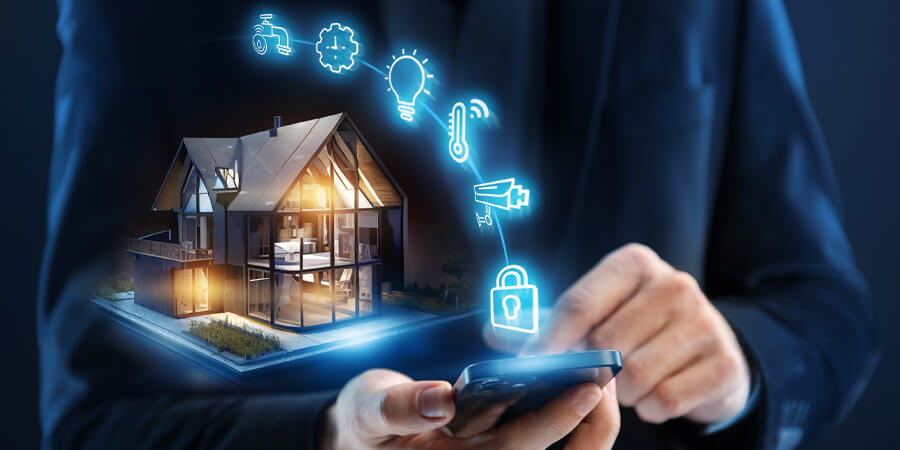In 2022, approximately 57.4 million individuals embraced the use of smart home devices, illustrating the widespread adoption of artificial intelligence (AI) and the Internet of Things (IoT) in our daily lives. In light of the growing numbers of people engaging with these technologies, it becomes imperative to delve into their functionalities and significance.
A Review of IoT
IoT encompasses a vast network of interconnected devices and technology enabling seamless communication between them, both with the cloud and among themselves. This concept consists of two main components: the digital and the physical.
For example, think of smart outlets, which monitor electricity usage and enable remote control of specific outlets or automated energy-saving routines. These features empower users to reduce their home energy consumption.
IoT devices often include additional functionalities for specific connectivity and purposes, such as telematics for industrial and commercial efficiency, as well as integrations with virtual reality (VR). Manufacturers of smart devices aim to enhance connectivity and communication across greater distances by incorporating these features into home networks.
The Interaction Between AI and IoT
Several methods exist for incorporating AI into various IoT devices to enhance the connectivity and efficiency of your smart home, like:
- Enhancing Home Security:
AI integration into home security systems can effectively bolster safety measures. For instance, an AI-equipped smart camera can continuously monitor movements and distinguish between different types of activity in its field of view. This capability provides homeowners with valuable insights about their property, eliminating the need for manual review of lengthy surveillance footage.
- Enhancing Energy Efficiency:
IoT can collaborate with AI to enhance energy conservation. Smart appliances, intelligent outlets and various IoT devices equipped with sensors can autonomously detect usage patterns and adjust energy consumption accordingly. Moreover, IoT technology empowers remote control of devices such as thermostats, security systems and lighting via your smartphone. This ensures that you never inadvertently leave the lights on or forget to adjust the thermostat while away from home, contributing to energy savings.
- Enhancing Interconnectivity Between Devices:
AI and IoT technologies collaborate to elevate seamless integration and interaction among smart and mobile devices. Given that the majority of AI and IoT functions operate over the internet, they can effectively communicate with other internet-connected devices, such as smartphones or smartwatches, integrated into your home automation system. This enables convenient centralized control of all your smart home devices at your fingertips, eliminating the need for manual device-by-device data retrieval or command execution.
Furthermore, devices like smart routers leverage AI to intelligently prioritize connected devices on your Wi-Fi network, ensuring faster internet speeds and optimizing internet coverage for all your home devices.
Key Considerations for Integrating AI and IoT Into Your Smart Home
When contemplating the integration of AI and IoT devices into your home, several crucial factors warrant your attention. The mere presence of these devices does not automatically transform your residence into a "smart home."
Firstly, it's essential to consider device compatibility. Not all devices have universal compatibility, and assessing compatibility, especially for IoT devices reliant on it for optimal functionality, is essential. You can find information on device compatibility online or from device retailers.
Secondly, make thoughtful selections. The primary goal of smart homes, along with AI and IoT devices, is to enhance efficiency, not complexity. Evaluate your daily routines and how these devices can simplify them. For instance, if you are not an avid gardener, investing in a smart hydroponic system, even if your home and devices support it, may not be practical.
Maintenance and upkeep are equally important considerations. As previously mentioned, the devices you select require maintenance, software updates and potentially hardware upgrades. When envisioning your smart home, consider the short-term and long-term maintenance requirements. Be sure that you are willing to commit to these tasks.
Lastly, factor in the total cost of ownership. Beyond just the device price, include one-time expenses, such as upgrading your home Wi-Fi, and recurring costs like subscriptions for device security (e.g., VPN). Some insurance companies may offer incentives for installing smart security devices, potentially offsetting overall costs. Compile a comprehensive list of expenses and potential savings to establish a final budget for your smart home devices.
While the initial setup might appear intricate, incorporating AI and IoT devices into your smart home has the potential to significantly enhance your quality of life. As technology continues to advance, individuals with compatible smart homes stand to reap the myriad benefits of cutting-edge technology.
